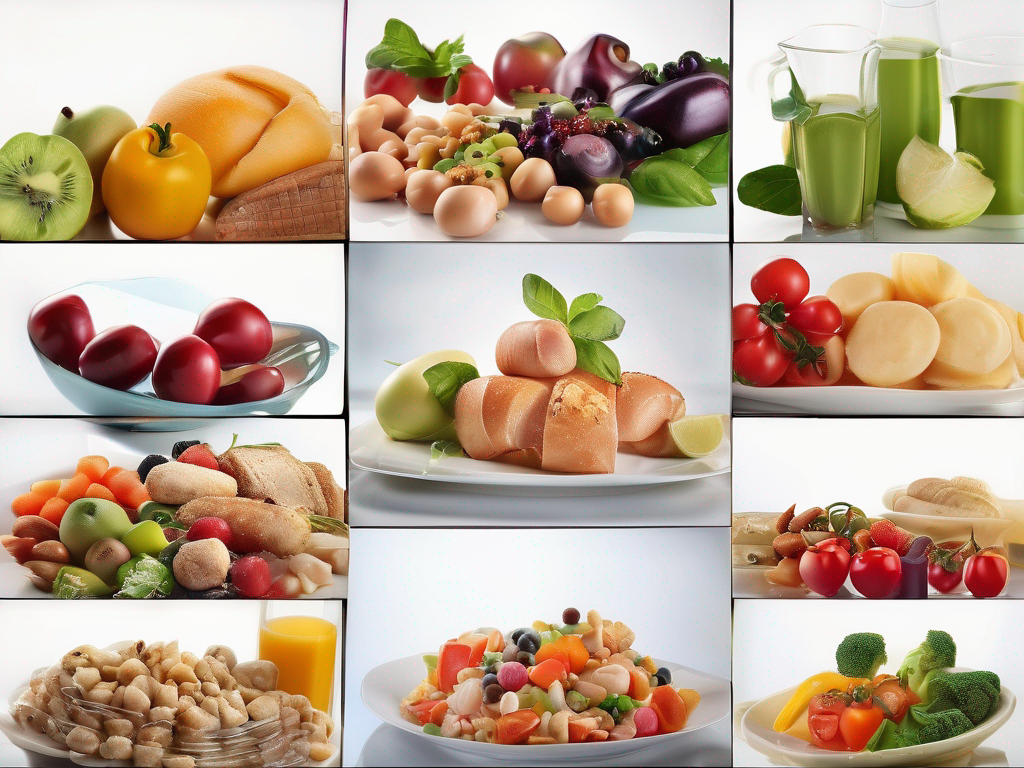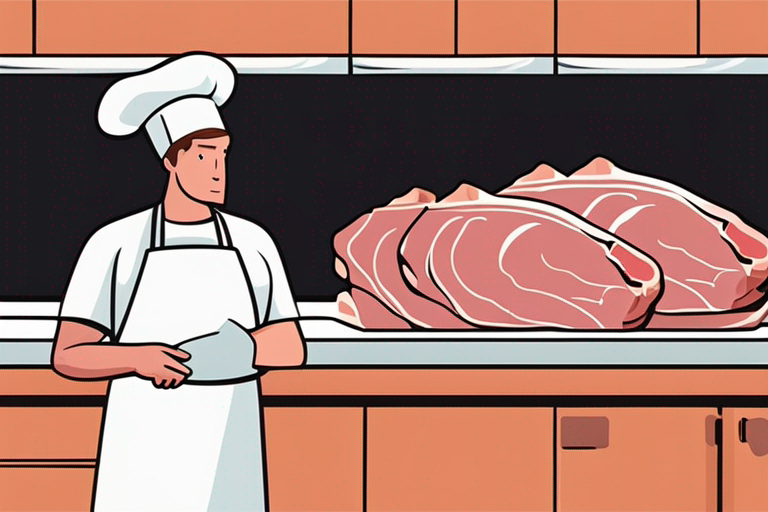
Can You Cook Frozen Meat Without Thawing?
Get Your Free Food Safety Cheat Sheet
30 most common foods with instant answers. Print it and stick it on your fridge—completely free!
# Can You Cook Frozen Meat Without Thawing?
In the hustle and bustle of daily life, it's not uncommon to find yourself reaching for a frozen piece of meat for dinner at the last minute. But is it safe to cook frozen meat without thawing it first? In this post, we'll explore the ins and outs of cooking frozen meat directly and discuss the best practices for ensuring both safety and delicious results.
## Understanding the Safety Concerns
When it comes to cooking frozen meat, there are some important safety considerations to keep in mind. Here's why thawing meat before cooking is typically recommended:
### Bacterial Growth
- Frozen meat takes longer to reach the safe cooking temperature, allowing bacteria to multiply.
- Cooking frozen meat may result in uneven cooking, leaving some parts undercooked and potentially unsafe to eat.
### Quality and Taste
- Thawing meat allows for more even cooking, resulting in a better texture and taste.
- Frozen meat can release excess moisture during cooking, affecting the overall flavor and texture of the dish.
## Real-Life Scenarios
Imagine this: It’s a Wednesday evening, and after a long day at work, you’re too tired to make a trip to the grocery store. You open your freezer and find a package of chicken breast that you forgot about. You’re tempted to throw it into the oven straight from the freezer. Sound familiar? Many people find themselves in this situation, but understanding how to do it safely is key.
Another relatable scenario is when you’re hosting a dinner party and realize an hour before guests arrive that you forgot to thaw the steak. Instead of panic setting in, knowing how to cook frozen meat can save the day. You might opt for a slow cooker or instant pot, allowing you to cook that frozen steak to perfection while entertaining your guests.
Lastly, consider a busy parent who forgot to pack lunch for their child. In a pinch, cooking frozen meat quickly for a healthy meal might seem like the only option. Understanding the best methods helps ensure that the meal is both safe and tasty.
### More Real-Life Examples
Let’s expand our scenarios a bit more. Picture a college student who has just come back from a study group, feeling famished. They remember they have some frozen ground beef in the freezer but have no time to thaw it. Instead of ordering takeout, they decide to make a quick spaghetti sauce by cooking the meat straight from frozen. By using a skillet over medium heat and a splash of water, they manage to cook up a delightful sauce in no time, proving that even in a pinch, creativity can lead to satisfying meals.
Or think about a busy couple who plan a romantic dinner but forget to defrost the salmon. With just thirty minutes before their reservation, they place the frozen fillets in a preheated oven and season them while cooking. The result? A perfectly cooked dish complemented by a side of steamed vegetables, turning a potential disaster into a lovely evening.
## Tips for Cooking Frozen Meat Safely
While thawing meat before cooking is generally recommended, there are ways to cook frozen meat safely if you're in a time crunch. Here are some tips to keep in mind:
### Choose the Right Cooking Method
- Opt for cooking methods that allow for longer cooking times, such as roasting or braising.
- Avoid methods like grilling or pan-searing, which require more even heat distribution.
### Adjust Cooking Times and Temperatures
- Increase the cooking time and lower the cooking temperature to ensure thorough cooking without burning the outer layer.
- Use a meat thermometer to check the internal temperature of the meat to ensure it reaches the safe minimum temperature.
### Avoid Cross-Contamination
- Wash your hands and any surfaces that come into contact with the frozen meat to prevent the spread of bacteria.
- Use separate cutting boards and utensils for raw and cooked meat to avoid cross-contamination.
### Consider Partial Thawing
- If time allows, consider partially thawing the meat in the refrigerator before cooking to reduce cooking time and ensure more even cooking.
## Common Mistakes
While cooking frozen meat can be done safely, many people make common mistakes that can compromise food safety and quality. Here are a few to watch out for:
### Ignoring Safety Temperatures
One of the biggest mistakes is not using a meat thermometer. People often rely on visual cues alone, which can be misleading. For instance, chicken might look cooked on the outside but still be raw on the inside. Always ensure your meat reaches the appropriate internal temperature.
### Thawing on the Counter
A common misconception is that it’s okay to thaw meat on the countertop. This practice can lead to bacteria growth, as the outer layer of the meat can reach temperatures conducive to bacterial multiplication while the inside remains frozen. Always thaw in the fridge or use cold water methods.
### Skipping Seasoning
When cooking frozen meat, people sometimes forget to season it properly. The seasoning is often washed away by the moisture released during cooking. To combat this, consider coating your frozen meat with seasoning in advance, or apply it during the last 10-15 minutes of cooking.
### Underestimating Cooking Times
Many people underestimate how much longer it takes to cook frozen meat compared to thawed meat. It can take up to 50% longer to reach the safe internal temperature, so make sure to adjust your cooking times accordingly.
## Best Practices for Safe Food Handling
Whether you choose to cook frozen meat directly or opt for thawing it first, following these best practices for safe food handling is essential:
### Storage and Thawing
- Store meat in the freezer at 0°F (-18°C) or below to prevent bacterial growth.
- Thaw meat in the refrigerator, cold water, or microwave, never on the countertop, to avoid the danger zone where bacteria can multiply.
### Safe Cooking Temperatures
- Cook ground meats to an internal temperature of 160°F (71°C) and whole cuts to 145°F (63°C) for safety.
- Use a meat thermometer to check the internal temperature of the meat, as color alone is not a reliable indicator of doneness.
### Leftover Storage
- Refrigerate leftovers promptly within two hours of cooking to prevent bacterial growth.
- Use shallow containers to store leftovers to promote rapid cooling and prevent the growth of harmful bacteria.
## Scientific Context
Understanding the science behind food safety can enhance your confidence in cooking frozen meat. When meat is frozen, the water inside its cells forms ice crystals. These crystals can damage the cell walls, which is why thawed meat sometimes appears less juicy. However, if you cook the meat directly from frozen, the cooking process can create steam, helping to keep the meat moist.
Furthermore, the USDA advises that while cooking from frozen is safe, the cut of meat and thickness play crucial roles in safe cooking. Thicker cuts, such as roasts, may need more time to cook thoroughly than thinner items like chicken breasts or burgers.
### Nutritional Considerations
Cooking frozen meat can also impact its nutritional value, though there is not a significant difference when compared to thawed meat. However, if you’re adding any sauces or marinades, keep in mind that frozen meat might not absorb flavors as well as thawed meat. For maximum flavor, consider marinating your meat before freezing it, allowing the flavors to infuse while it thaws and cooks.
### Preservation Methods
Freezing is one of the most effective methods to preserve meat, helping to maintain its nutritional quality while preventing spoilage. However, it's essential to wrap meat tightly in vacuum-sealed bags or freezer paper to prevent freezer burn, which can degrade the taste and texture.
## Expert Insights
Professional chefs and food safety experts recommend planning ahead when possible. If you anticipate using frozen meat frequently, consider organizing your meals around it. This can help you avoid the need to cook from frozen altogether. Additionally, many recommend using a slow cooker or pressure cooker with frozen meat, as these methods excel at evenly distributing heat and moisture, resulting in tender, flavorful dishes.
Moreover, it’s beneficial to label your frozen meat with the date it was frozen. This simple step can help you manage your inventory effectively, ensuring you use older items first and reducing waste.
## Safety Warnings
While cooking frozen meat can be perfectly safe, it’s crucial to be aware of some important cautions:
- Never refreeze meat that has been thawed unless it has been cooked first. Refreezing raw meat can lead to a loss in quality and potential safety issues.
- Always prioritize cleanliness by sanitizing surfaces and hands after handling raw meat to minimize the risk of cross-contamination.
- Be cautious with pre-cooked frozen meals. Even though they may appear ready to eat, they often need to be heated to the right temperature to ensure safety.
## Conclusion
While it's generally recommended to thaw meat before cooking for safety and quality reasons, cooking frozen meat directly can be done safely with the right precautions. By following the tips and best practices outlined in this post, you can enjoy a delicious meal without compromising on food safety. Remember to always prioritize safe food handling practices to protect yourself and your loved ones from foodborne illnesses. With a little awareness and preparation, you can make cooking frozen meat a hassle-free experience.

Authoritative Food Safety References
These agencies and university labs inform every tip and health precaution we publish.
USDA FoodKeeper – Cold Storage Guidelines
Official refrigerator, freezer, and pantry timelines maintained by the U.S. Department of Agriculture.
Visit USDA FoodKeeperFDA Produce Safety Rule & Grower Guidance
Field-to-fridge handling practices that prevent contamination of fruits, vegetables, and leafy greens.
Visit FDA Produce SafetyCDC Foodborne Illness Prevention Hub
Surveillance-backed guidance on pathogens, symptoms, and steps to reduce foodborne illness risk.
Visit CDC Food SafetyUC Davis Postharvest Technology Center
University research detailing optimal storage atmospheres for produce after harvest.
Visit UC Davis PostharvestPenn State Extension – Home Food Preservation & Safety
Peer-reviewed extension bulletins on safe canning, chilling, and reheating practices.
Visit Penn State ExtensionCan you cook frozen meat without thawing it first?
What is the best way to cook frozen meat?
Is it safe to cook frozen meat without thawing?
How do I know when frozen meat is fully cooked?
Can I refreeze meat that has been cooked from frozen?
Get Your Free Food Safety Cheat Sheet
30 most common foods with instant answers. Print it and stick it on your fridge—completely free! Want more? Upgrade to the complete guide with 70+ foods.
Scan your food directly and get instant safety info using our AI-powered camera feature.